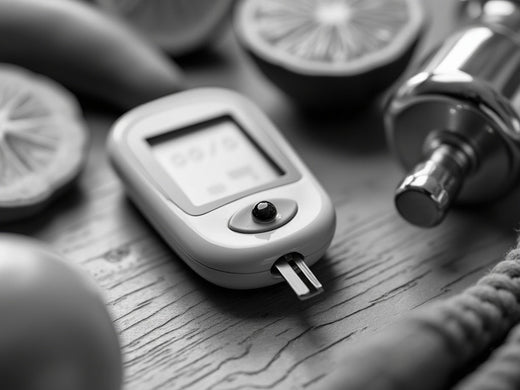
Top 7 Tips to Control After Eating Blood Sugar Levels
Share
Controlling after eating blood sugar levels is crucial for maintaining overall health and preventing long-term complications. The seven scientifically-backed strategies outlined in this article offer practical ways to manage postprandial glucose spikes, combining dietary choices, physical activity, and innovative monitoring techniques to manage blood sugar after a meal.
- Balanced meal composition using the plate method helps regulate glucose absorption
- A brief 10-15 minute walk after meals can significantly reduce blood sugar spikes
- Incorporating vinegar into meals may blunt glucose rises by 20-30%
- Continuous glucose monitoring provides real-time insights for better management
- Choosing low glycemic index foods and balancing meals with protein and fat are effective strategies
Understanding Blood Sugar Levels and Their Impact
After eating blood sugar levels, also known as postprandial glucose, play a crucial role in overall health. For non-diabetics, normal ranges should fall below 140 mg/dL two hours after eating, while those with diabetes aim for levels below 180 mg/dL. The International Diabetes Federation suggests that non-diabetic glucose shouldn't exceed 140 mg/dL post-meal.
Monitoring and managing these levels is vital, as prolonged elevated glucose can have serious health consequences. Research indicates a 40% increased risk of cardiovascular disease when levels remain above 150-180 mg/dL after meals for extended periods.

Factors Influencing After Eating Blood Sugar Levels
Several factors can impact postprandial glucose levels:
- Food choices: High glycemic index foods (GI >70) cause higher spikes
- Physical activity: A 10-15 minute walk after eating can reduce spikes by 22%
- Medications and insulin therapy: Continuous glucose monitoring (CGM) users spend 70% more time in target glucose range
- Common triggers: Stress, illness, alcohol, and processed foods
An actionable tip to help manage glucose levels is to stay adequately hydrated, aiming for 2-3 liters of water daily. This simple habit can aid in blood sugar regulation and prevent post-meal spikes.
Top 7 Tips to Control After Eating Blood Sugar Levels
1. Be Mindful of Food Ratios: Implement the plate method by filling half your plate with non-starchy vegetables, a quarter with lean protein, and a quarter with whole grains or low-GI carbs. This balanced approach helps regulate glucose absorption and provides essential nutrients.
2. Engage in Post-Meal Movement: A short 10-15 minute walk after eating can significantly improve glucose uptake by muscles, reducing blood sugar spikes. This simple habit can be easily incorporated into daily routines, whether it's a stroll around the block or some light housework.
3. Use the Second Meal Effect: Consuming high-fiber snacks before meals can reduce glucose absorption by 15-30 mg/dL. This strategy takes advantage of the body's natural response to previous food intake, helping to blunt sugar spikes from subsequent meals.
4. Add Vinegar to Meals: Incorporating 1-2 tablespoons of vinegar before or during meals can blunt blood sugar spikes by 20-30%. Apple cider vinegar gummies offer a convenient and palatable option for those who find liquid vinegar unappealing.
5. Consider Continuous Glucose Monitoring (CGM): These devices provide real-time insights into glucose levels, allowing for immediate adjustments to diet and activity. CGM users often spend significantly more time in their target glucose range, leading to better overall management.
6. Choose Low Glycemic Index Foods: Opt for foods with a lower glycemic index to minimize blood sugar spikes. For example, swap white rice for quinoa or brown rice. These choices can help maintain steadier glucose levels after meals.
7. Balance Meals with Protein and Fat: Adding protein and healthy fats to meals slows carbohydrate absorption, resulting in a more gradual rise in blood sugar. This strategy can be particularly effective when combined with exogenous ketones for those following a ketogenic diet.
Frequently Asked Questions
Q1: What is a normal blood sugar level 2 hours after eating?
A: For individuals without diabetes, levels should return to below 140 mg/dL. Those with diabetes aim for levels below 180 mg/dL.
Q2: How can I prevent blood sugar spikes after a meal?
A: Combine low-GI foods, engage in physical activity, and stay hydrated. Including protein and fat with carbs can also help slow glucose absorption.
Q3: What happens if blood sugar stays high after eating?
A: Frequent spikes increase risks of complications like nerve damage and heart disease. It's important to consult a healthcare provider if levels persistently exceed targets.
Q4: Is walking after eating better than before?
A: Yes, studies show that exercising post-meal lowers after eating blood sugar levels more effectively than pre-meal activity.
By implementing these strategies and staying informed about your body's response to different foods and activities, you can effectively manage after eating blood sugar levels. Remember, consistent efforts in diet, exercise, and monitoring can lead to significant improvements in overall health and well-being.1-5
- Sources:
- WebMD [Internet]. How to Manage Blood Sugar Spikes After Meals. [cited 2023]. Available from: https://www.webmd.com/diabetes/how-manage-blood-sugar-spikes-after-meal
- Levels [Internet]. What should your glucose levels be? The 2024 Levels Guide to ... [cited 2023]. Available from: https://www.levels.com/blog/what-should-my-glucose-levels-be-ultimate-guide
- Know Diabetes [Internet]. Those bothersome blood sugar spikes after meals… [cited 2023]. Available from: https://www.knowdiabetes.org.uk/blog/those-bothersome-blood-sugar-spikes-after-meals/
- Healthline [Internet]. Normal Glucose Levels After Eating. [cited 2023]. Available from: https://www.healthline.com/health/diabetes/normal-glucose-level-after-eating
- American Diabetes Association [Internet]. Glycemic Targets: Standards of Medical Care in Diabetes—2021. [cited 2023]. Available from: https://care.diabetesjournals.org/content/44/Supplement_1/S73








